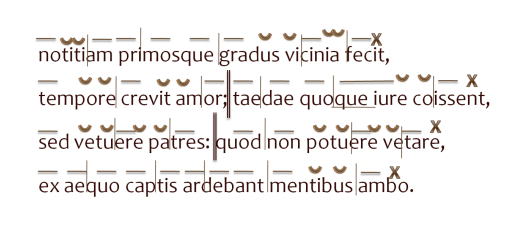
Scansion Basics
Listed below are the basic steps for scanning latin poetry, along with an example.
Mark all elisions- This is when a word ends in a vowel or the letter M and begins in a vowel or the letter H. You can only pronounce the vowel starting on the second word
Ex: “atque altae”, “multum ille”, “virum hunc”
Mark all syllables containing a long vowel long
ā is pronounced like the a in father
ē is pronounced like the e in they
ī is pronounced like the ee in sheep
ō is pronounced like o in amore
ū is pronounced like the oo in english root
Mark all syllables containing a dipthong long
Dipthong vowel combinations may be: ae, au, oe, ui, eu, ei
Ex: “meī”, “audēo”, “deīnde”
Mark all syllables that are followed by 2 consonants
Ex: “āggerat”
Mark everything else short, make sure there are 6 feet of dactyls and spondees.
The fifth foot is almost always a dactyl and the sixth foot is almost always a spondee.

Scansion Basics
Listed below are the basic steps for scanning latin poetry, along with an example.
Mark all elisions- This is when a word ends in a vowel or the letter M and begins in a vowel or the letter H. You can only pronounce the vowel starting on the second word
Ex: “atque altae”, “multum ille”, “virum hunc”
Mark all syllables containing a long vowel long
ā is pronounced like the a in father
ē is pronounced like the e in they
ī is pronounced like the ee in sheep
ō is pronounced like o in amore
ū is pronounced like the oo in english root
Mark all syllables containing a dipthong long
Dipthong vowel combinations may be: ae, au, oe, ui, eu, ei
Ex: “meī”, “audēo”, “deīnde”
Mark all syllables that are followed by 2 consonants
Ex: “āggerat”
Mark everything else short, make sure there are 6 feet of dactyls and spondees.
The fifth foot is almost always a dactyl and the sixth foot is almost always a spondee.

 Knowt
Knowt
